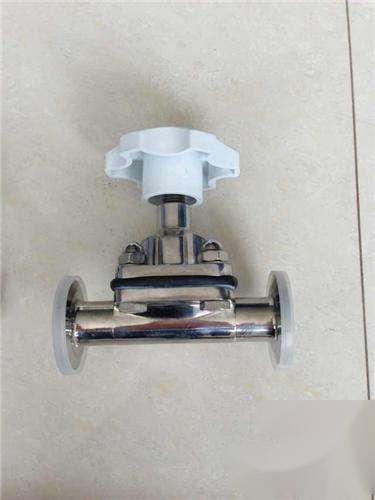Application: Beer, pharmaceuticals, dairy products, beverages, pipeline engineering, machinery manufacturing, chemical industries, etc.
Material: Stainless steel 304 and 316L
Maximum working temperature: 150℃ (depending on usage conditions)
Diaphragm material: EPDM\PTFE
Body material: Stainless steel 304 or 316
Maximum working pressure: 6 kg (when diaphragm is made of EPDM or fluorinated rubber) 4 kg (when diaphragm is made of PTFE)
Air source control pressure: 5-7 Bar
Product attributes: Stainless steel diaphragm valve series, precision manufacturing
Connection form: Quick installation, threaded, welding (optional)
Standard: DIN, ISO
Introduction: Sanitary diaphragm valves can be remotely controlled by a drive device or manually operated via a handle. The drive device has three standards: normally closed, normally open, and air-to-air. It features a simple structure, aesthetic design, quick disassembly, flexible operation, and low fluid resistance. It is suitable for controlling water, gas, oil, and corrosive media in industries such as chemical, petroleum, metallurgy, water heating, food, and pharmaceuticals.
Applicable scope: Due to the structural design of the diaphragm valve itself, it is particularly suitable for ultra-pure media or severely contaminated, highly viscous liquids, gases, corrosive or inert media. When combined with control devices, diaphragm valves can replace other traditional control systems, especially suitable for solid and easily contaminated inert media.
Characteristics of sanitary diaphragm valves:
The main characteristic of sanitary diaphragm valves is that the diaphragm separates the internal cavity of the lower valve body from the internal cavity of the upper valve cover, preventing the valve rod, valve disc, and other parts located above the diaphragm from being corroded by the medium, eliminating the need for packing sealing structures and preventing medium leakage. Further details:
1. The diaphragm made of soft sealing materials such as rubber or plastic has good sealing performance. Since the diaphragm is a consumable part, it should be replaced regularly based on the characteristics of the medium.
2. Due to limitations of diaphragm materials, diaphragm valves are suitable for low pressure and relatively low temperature applications. There are various types of aerosol sampling valves, classified from different perspectives.
3. According to structural form, they can be divided into six types: roof type, direct current type, cutoff type, through type, gate type, and right-angle type; connection form is usually flange connection; according to the driving method, they can be divided into manual, electric, and pneumatic, among which pneumatic drive can be further divided into normally open, normally closed, and reciprocating types.
4. Sanitary diaphragm valves are generally not suitable for use in pipelines with temperatures above 60 degrees or transporting organic solvents and strong oxidizing media, nor should they be used in high-pressure pipelines. In response to the demands of social development, sanitary diaphragm valves have been widely used in major food manufacturing industries and are expected to continue to gain market recognition.
Working principle: Can be remotely controlled by a drive device or manually operated via a handle.













